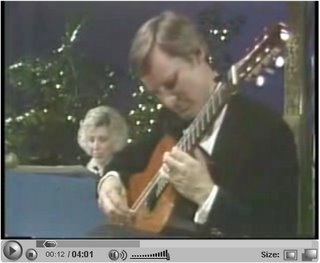It's tragically hip in some circles to diss Bach. After all, he worked for a living as a composer, got paid to write his little ditties. I mean, he really never busked on street corners or paid to play at the Whiskey in hopes the A&R guy from A&M might stop by. So how could he have any real cred? Well, for starters, the dude could compose. In among all the contrapuntal frenzies were such show-stoppers as "Air on a G String" and "Sheep May Safely Graze." And he takes some heat for recycling. As one example, the same melody shows up as:
- "Sinfonia to Cantata #29" BWV 29
- "Partita for Solo Violin, E Maj" BWV 1006
- "Suite for Lute, E Maj" BWV 1006a
Top 5 Instrumentals
1. Cliffs of Dover, Eric JohnsonA rollicking romp on the strings, soaring ever higher, to an impossibly beautiful conclusion.2. Partita for solo violin No. 3., E major, Prelude, J. S. BachA rollicking romp on the strings, soaring ever higher, to an impossibly beautiful conclusion.3. Miserlou, Dick DaleMade recently famous by Pulp Fiction. Listen to how tough and assertive it sounds, and imagine how that played in '61. Damn scary guitar playing.4. In The Mood, Glenn Miller
This was a transition from mannered swing music to R 'n' B of the '50s. It's really all rock 'n' roll.
5. Walk, Don't Run, The Ventures
Pre surf guitar, post jazz, proved that intense doesn't have to equate to loud. This song swings really hard, but keeps the lid on the volume pressure cooker. Rocks with subtleties, not volume. But it's fun to play loud, too.
Honorable mention:
Peter Gunn Theme, Henry Mancini
My friend Al Schmitt recorded this, along with all Mancini's work. Bob Bain, later of The Tonight Show, played lead guitar.
Parkening Plays Bach, Christopher Parkening
Andres Segovia wrote the entire book on classical guitar, esp. re: Bach transcriptions of violin, cello, keyboard, and choral pieces. Parkening took it to a new level with this album. Technically daunting ( I made it through Prelude in C, Well Tempered Klavier, but that's about it), and breathtakingly beautiful, it emphasises not only Bach's contrapuntal art but also the melodies. Ah, the melodies...
Embryonic Journey, Jefferson Airplane (Korma Kaukonen solo)
Starting to get the ideal that I play guitar? Not as well as Jorma. Just a quick slice of lovely fingerstyle guitar playing, with a wonderful melody and flawless tone. Anybody really into fingerstyle would do well to study this man's work.
Steppin' Out, Cream: "Live Cream, Vol. 2
Back in the day, when Eric Clapton was young and hungry, he helped define the vocabulary of rock guitar playing. This 14 minute exercise shows the dexterity and depth of this guy's fingers. He never plays the same lick twice, and, while it would be foolish to compare him to Charlie Parker, the similarity is that both played with passion, skill, and new ideas in their day. Contrast this to the later work done by Mr. Clapton, pop star and much calmer persona. The young Eric really had something to say.
For additional homework, and to learn more about guitar music, look up: Clarence White, Doc Watson, & Lenny Breau. Especially Lenny Breau.
So yes, the Bach piece really does it for me. It's a fantastic melody, folded inside an intense rhythm and chord structure. And it doesn't start off softly. Instead it immediately jump out, grabs your ears, and pulls you along for the short breathtaking ride. It's a little bit like a great roller coaster, if they could figure out how to start at 60 MPH rather than have to build up to that speed. In this way, music demonstrates that this intangible art can supercede the laws of physics, which is one of its great appeals to us mortals.
Which of the three settings is best? Is Chateau Lafite better than Petrus? Come on, that's a silly question. The violin version is the most exciting, because of the nature and scope of the instrument. And the limited ability to hint at chords makes the musical tension exquisite. As with all solo violin work, the listener must interpolate the chords at which the instrument only hints. And the variety of bow attacks and dynamics gives the piece drama unavailable elsewhere.
Here's a great version of the solo violin version:

The lute setting is the most restrained and introspective, again, due to the delicate nature of the instrument. (For guitarists who have never played a lute, the instrument is surprising. It looks large and physically intimidating, yet the voice it produces is so subtle, so soft, that it forces the player into a competely different, smaller, more intimate mind-space.)
And the Cantata (vocal) version is pretty over the top, especially if one favors solo instrumentals. But it still rocks, pretty hard.
Now the guitar version, of any of the 3 actual Bach arrangements, gives yet takes away. Yes, there is the ability to chord, also present in the lute. And there is greater dynamic range and tonal palette than the lute, although not as diverse as the violin. So it perhaps is the richest variation of the Bach melody.
As I have mentioned before, Christopher Parkening has taken classical guitar, especially Bach transcriptions, to a completely new level. I made my way through his Parkening Plays Bach slowly, mastering only the Prelude #1 in C, for the Well Tempered Clavier.
Here's Chris playing the choral version, with only a slight harpsichord accompaniment.

This rocks. Enjoy. And compare/contrast to the violin version above.
As an added attraction, here's Li Jie performing Bach's Prelude to the Solo cello Suite in G Maj:

Don't know much about her, except that she plays with a maturity and soul that's unexpected in someone who seems so young.
No comments:
Post a Comment